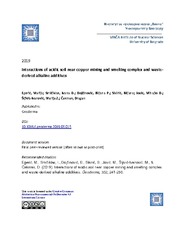Приказ основних података о документу
Interactions of acidic soil near copper mining and smelting complex and waste-derived alkaline additives
| dc.creator | Egerić, Marija | |
| dc.creator | Smičiklas, Ivana D. | |
| dc.creator | Dojčinović, Biljana P. | |
| dc.creator | Sikirić, Biljana | |
| dc.creator | Jović, Mihajlo D. | |
| dc.creator | Šljivić-Ivanović, Marija Z. | |
| dc.creator | Čakmak, Dragan | |
| dc.date.accessioned | 2019-11-26T13:46:40Z | |
| dc.date.available | 2021-06-19 | |
| dc.date.issued | 2019 | |
| dc.identifier.issn | 0016-7061 | |
| dc.identifier.uri | https://vinar.vin.bg.ac.rs/handle/123456789/8368 | |
| dc.description.abstract | Liming is a common practice in the treatment of acidic and metal contaminated soils, aiming at pH regulation, enhancing of the nutrient availability and attenuation of trace metals mobility. Replacement of natural limestone with alternative soil alkalizers found among waste materials represents a step towards sustainable resource management and reduced waste storage. In this study, waste seashells (SW) and red mud (RM) were applied in different doses to the soil sampled in the vicinity of mining and smelting complex. The soil was characterized by acidic reaction (pH 4.93), increased Cu concentration (219.2 mg/kg) and a very low level of P-supply (3.61 mg P2O5/100 g). The study aimed to quantify and compare additive-induced effects onto soil physicochemical properties, the status of macronutrients and distribution of trace metals. Targeted effect on soil pH was achieved with SW dose of 0.3% and RM dose of 2%. RM was found to be a source of available P and gave rise to the available P concentrations in the soil. Medium level of P-supply (15.60 mg P2O5/100 g) was achieved with RM dose of 5%, however, the increase in soil salinity and total trace elements concentrations have become significant adverse effects at such dose. The decrease in the ion-exchangeable content of Cu and other trace metals was in correlation with the increase in soil pH after the treatments. Redistribution of metal cations was mainly directed to carbonate/acid soluble and Fe, Mn-oxide bonded fraction after SW addition. Even though trace metals concentration has increased in the soil after application of the RM, they were principally found in the residual fraction. The results emphasize low amounts of contained trace elements and lower doses for achieving targeted effects on pH and metal mobility as the main benefits of SW treatments. On the other hand, moderate and controlled use of RM may represent multiple benefits in terms of simultaneous pH regulation, P-supply, and reduced trace metals mobility. © 2019 Elsevier B.V. | en |
| dc.language.iso | en | |
| dc.relation | info:eu-repo/grantAgreement/MESTD/Integrated and Interdisciplinary Research (IIR or III)/43009/RS// | |
| dc.relation | info:eu-repo/grantAgreement/MESTD/Technological Development (TD or TR)/37006/RS// | |
| dc.relation | info:eu-repo/grantAgreement/MESTD/Basic Research (BR or ON)/173018/RS// | |
| dc.rights | embargoedAccess | |
| dc.rights.uri | https://creativecommons.org/licenses/by-nc-nd/4.0/ | |
| dc.source | Geoderma | |
| dc.subject | Acidic soil | en |
| dc.subject | Remediation | en |
| dc.subject | Waste recycling | en |
| dc.subject | Red mud | en |
| dc.subject | Seashell waste | en |
| dc.title | Interactions of acidic soil near copper mining and smelting complex and waste-derived alkaline additives | en |
| dc.type | article | en |
| dc.rights.license | BY-NC-ND | |
| dcterms.abstract | Егерић, Марија; Смичиклас, Ивана Д.; Дојчиновић, Биљана П.; Сикирић, Биљана; Јовић, Михајло Д.; Шљивић-Ивановић, Марија З.; Чакмак, Драган; | |
| dc.date.updated | 2020-11-30T10:10:52Z | |
| dc.citation.volume | 352 | |
| dc.citation.spage | 241 | |
| dc.citation.epage | 250 | |
| dc.identifier.wos | 000485207300024 | |
| dc.identifier.doi | 10.1016/j.geoderma.2019.06.015 | |
| dc.citation.rank | aM21 | |
| dc.description.other | This is the peer reviewed version of the following article: Egerić M, Smičiklas I, Dojčinović B, Sikirić B, Jović M, Šljivić-Ivanović M, Čakmak D. Interactions of acidic soil near copper mining and smelting complex and waste-derived alkaline additives. Geoderma. 2019;352:241–50. [http://dx.doi.org/10.1016/J.GEODERMA.2019.06.015] | |
| dc.description.other | Published version: [https://vinar.vin.bg.ac.rs/handle/123456789/8345] | |
| dc.type.version | acceptedVersion | |
| dc.identifier.scopus | 2-s2.0-85067396931 | |
| dc.identifier.fulltext | https://vinar.vin.bg.ac.rs/bitstream/id/20800/Geoderma_2019_Accepted.pdf |
Документи
Овај документ се појављује у следећим колекцијама
-
Radovi istraživača
Researchers' publications

